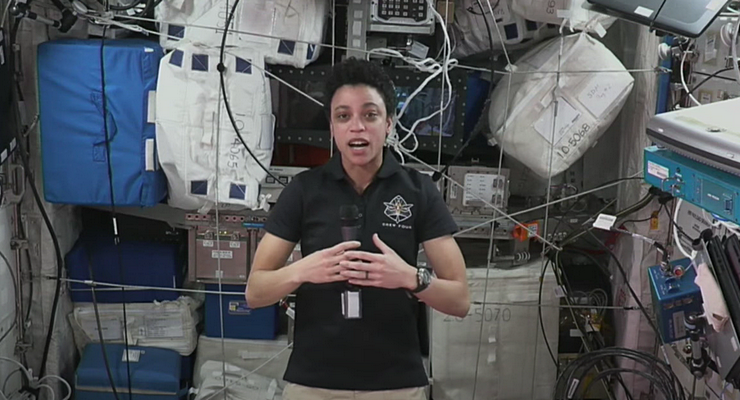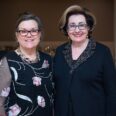
Apart from being a NASA astronaut, geologist, aquanaut and former international rugby player, Watkins is the first Black woman scheduled to complete an International Space Station long-term mission.
“Follow your passion, work hard, find mentors, and get all the support you need from people who believe in what you’re doing,” Watkins said during the broadcast from ISS.
Watkins, who did her postdoc at Caltech in Pasadena, spoke using a NASA TV live feed from the ISS on Tuesday and recalled how being at Caltech helped her shape her path towards becoming an astronaut – one who’s actually looking at possibly being on the first manned mission to Mars in the near future.
Watkins spent two years working on the Mars Science Laboratory (MSL) mission’s Curiosity rover when she was selected for the 2017 astronaut class. At Caltech, she worked with John Grotzinger, the Harold Brown Professor of Geology and Ted and Ginger Jenkins Leadership Chair for the Division of Geological and Planetary Sciences (GPS).
“I think my time at Caltech really did help shape who I am as a researcher as well as enabled me to be successful in this job and be a candidate for this role,” she said.
“One of the main things for me being at Caltech was being able to be in that environment where you’re just immersed in an academic world with experts in their fields, as well as being close by to JPL. For me, that meant access to internships and being able to experience more of the kind of operational world as well, and getting to interact with engineers as well as the scientists in my department at Caltech.”
‘We’re looking into how long-duration space flight affects the human body and brain’
Aboard the ISS, Watkins, among other tasks, conducts experiments in the microgravity environment that exists there, in ways that could not be done on Earth. She says those tasks include looking at how materials behave in microgravity and looking at how cells and tissue grow in such an environment.
“We have a study up here looking at immune cells and how they age in microgravity, and then also looking at how that immune function changes post-flight and whether it recovers,” Watkins said. “We also are looking at human science; of course then we become the test subjects. And we’re looking into how long-duration space flight affects the human body and brain.”
Watkins’ job also connects her with NASA’s Earth Surface Mineral Dust Source Investigation (EMIT) mission, which studies the heating or cooling effect of mineral rock dust on Earth’s atmosphere that can travel thousands of miles and affect different continents. That dust, suspended in the air, can either heat or cool the atmosphere and Earth’s surface. It can also help form clouds or change atmospheric chemistry and can either help or harm ecosystems, depending on where the dust falls.
“Of course, near and dear to my heart and to many of yours is Earth and space science,” Watkins said. “One of my favorite experiments going on right now up here in that arena is EMIT, which I know some of you are very familiar with. So there’s a lot that we can use to take advantage of ISS’s unique vantage point both for Earth observations as well as for scientific observations on board.”
A Colorado native, Watkins earned a BS in Geological and Environmental Sciences from Stanford University and a Doctorate in Geology from UCLA. She conducted her graduate research on the emplacement mechanisms of large landslides on Mars and Earth. Aside from JPL, she has also worked at NASA’s Ames Research Center about the time she was a science team collaborator for Curiosity.
For college students who are looking forward to a career as an astronaut, Watkins said there is no clear career path to it, but it is important for any student to pursue something he or she is passionate about.
“The one thing that all of my classmates and my crew mates have in common is that we don’t have the same background. We all came from different experiences and different career paths that led us to this point,” she said. “So find something that you enjoy, that gets you out of bed in the morning, and pursue that. Find opportunities to pursue that.”
Watkins did find many of those opportunities at Caltech and JPL as well as the other NASA centers she’d been with.
“There’s something that I heard a lot growing up, especially from my parents and teachers and mentors, but it’s something I’m not sure I fully believed until now, and that’s that hard work really does pay off,” Watkins said. “There are very very few circumstances where working your hardest, putting your all into something, will be something that you regret, particularly if it is something that you are passionate about and something that you enjoy. So I would say to myself and also to other young people out there just continue to put one foot in front of the other, and work hard at whatever it is that you’re doing.”
In 2004, Watkins was 15 years old when a pair of robotic rovers, Spirit and Opportunity, landed on the surface of Mars.
“That was a really cool moment, and I kind of knew from then that it would be really awesome to work on a Mars rover,” Watkins said then.
Today, she’s more excited than ever just thinking of the possibility that she might be on one of the first – if not the first – manned missions to the Red Planet.
NASA’s Mars 2020 Perseverance rover is now on the surface of Mars and is looking for signs of past microbial life, cache rock and soil samples. All these are being studied on Earth, as NASA prepares for future human exploration on the planet.
“I’m super excited about what Perseverance is doing on Mars along with her older sister Curiosity,” she said. “I think it’s going to be really illuminating for us, hopefully give us some insight into the habitability of Mars and hopefully signs of ancient life as well. Those delta deposits will be the perfect place that if there are those signs there that’s where they will be. So I’m super excited about heading up there and then taking samples. I’m super excited about getting boots on the ground on the surface in the next several years.”














 1 comment
1 comment



